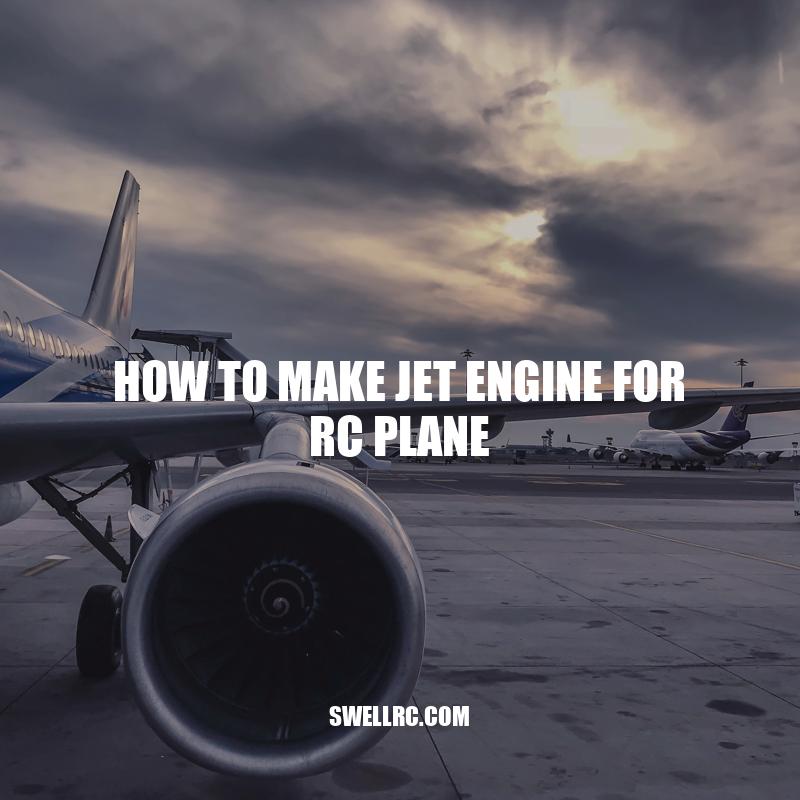DIY Jet Engine for RC Plane: Step-by-Step Guide
Building and flying remote-controlled airplanes is a hobby enjoyed by many enthusiasts worldwide. The excitement of constructing and successfully operating an aircraft can be an incredibly exhilarating experience. However, those who are particularly passionate about the hobby may want to take things to the next level by building an RC plane with a jet engine. Creating a functioning jet engine isn’t a task for the faint of heart, and it requires time and effort to succeed. That said, it’s an ideal challenge for experienced hobbyists looking to take their abilities to the next level. Whether you are looking to break speed records or create an extremely powerful flying machine, building a jet engine is a perfect place to start. This article will provide a brief overview of what you need to know to get started in building an RC plane with a custom-built jet engine. We will cover the basic materials you’ll need, the step-by-step process of building the engine, and the best tips and tricks to ensure that your plane has a smooth, successful takeoff and landing. By following these steps, you will have a functioning jet engine for an RC plane that will leave your fellow hobbyists amazed and envious.
Materials Needed
Before beginning any project, it’s essential to know the tools and materials you need to make sure you can complete it successfully. Here are some of the core items you will need to build your RC plane with a jet engine:
- A metal air tank
- A fuel injector
- A combustion chamber
- A turbine
- A compressor
- An exhaust nozzle
- A spark plug
- Basic tools such as pliers, screwdrivers, and a drill
Choosing the right parts and materials is crucial to building an RC plane with a jet engine that is safe and functional. You can purchase materials at hobby shops or online. There are also a variety of websites and forums that provide helpful information and advice for those interested in building a jet engine for their RC planes.
Are there RC planes with jet engines?
Yes, there are RC planes available with jet engines. These planes are designed to mimic the look and sound of real jet planes, and they can be quite thrilling to fly. However, they are typically more expensive and require more skill to operate than other types of RC planes. Some popular websites for purchasing RC planes with jet engines include Horizon Hobby and Motion RC.
Steps to Build a Jet Engine for RC Plane
Building a jet engine for your RC plane is a complex project that requires attention to detail and careful execution. Here are the basic steps to building a jet engine for your RC plane:
| Steps | Description |
|---|---|
| Step 1: Prepare the Compressor | Cut a plastic tube to the desired length and attach it to the front of the engine. Create blades by cutting plastic sheets and make a curved shape. Attach the blades to the inside of the tube and finally make a compressor blade housing with small PVC pipe. |
| Step 2: Construct the Combustion Chamber | Cut a metal tube and attach it to the compressor section. Build a spark plug and attach it to the chamber using a small piece of metal wire. |
| Step 3: Build the Turbine | Use two metal disks to make the turbine blades, and cut a larger metal disk to make the turbine housing. Drill holes in the disk, attach them to the housing, and attach the blade attachment points to the housing. |
| Step 4: Connect The Components | Attach the compressor section to the combustion chamber, and then attach the combustion chamber to the turbine section. Finally, attach the exhaust nozzle to the turbine section. |
It’s important to note that it can take time and patience to build a functioning jet engine. However, the final product can be an exciting and rewarding addition to your RC plane. There are also various websites and online forums where you can seek advice and share ideas with like-minded hobbyists who are also building jet engines for their RC planes.
How do you build a jet engine?
Building a jet engine is a highly technical and complex process that involves many different components and processes. Here are some basic steps:
- Design the engine: The design process involves extensive research, analysis and simulation using advanced software and tools.
- Fabricate the parts: Parts are manufactured to exacting tolerances using advanced manufacturing techniques such as 3D printing and precision machining.
- Assemble the engine: The individual parts are assembled into modules, which are then combined to make the complete engine.
- Test the engine: The engine is rigorously tested in a variety of settings to ensure that it meets all safety, performance and regulatory requirements.
If you’re interested in learning more about the specifics of building a jet engine, there are many websites and products available that provide detailed information on the subject.
Tips for Building a Jet Engine for RC Plane
When building a jet engine for your RC plane, there are a few things to keep in mind to ensure your project goes smoothly:
- Research: Before starting your project, research different designs and materials to ensure you have the necessary knowledge and resources.
- Tools: Make sure you have all the necessary tools before starting your project.
- Materials: High-quality materials, such as metal and plastic, are necessary to ensure your engine functions properly.
- Procedure: Follow the steps outlined in this article carefully to ensure you assemble your engine in the right order.
- Safety: Always practice safety when working with engines and flying your RC plane, including using protective gear and taking precautions when fueling your engine.
If you’re looking for additional guidance or products to help you build your jet engine, there are several websites and online communities that you can turn to, including:
RC Groups
RC Groups is an online community where hobbyists can share ideas, advice, and information regarding remote-controlled vehicles. With over a million members, RC Groups has a dedicated section for building jet engines specifically for RC planes.
AeroFred
AeroFred is a website that offers a library of RC planes and parts for hobbyists to download and print. They have several options for jet engine designs that can be 3D printed.
Keep these building tips in mind and seek out additional advice and resources when needed to make your jet engine building experience a success.
What is the best RC jet engine?
There are many RC jet engines on the market with varying levels of power, durability and price. Some of the highly-rated ones are:
- JetCat P220-RXi – reliable, high power output and advanced telemetry
- Turbine Solutions THM160 – highly efficient and compact
- InnovaJet TJ90 – lightweight, easy to maintain and fuel efficient
It’s important to do your own research and choose an RC jet engine that meets your specific needs and budget. Always refer to reputable manufacturers and distributors for reliable information and products.
Testing and Troubleshooting Your Jet Engine
After building your jet engine, it is essential to test it before flying your RC plane. Here are a few tips for testing and troubleshooting your engine:
- First test your engine without fuel to ensure all components are working correctly.
- Once the engine is running properly without fuel, add a small amount of fuel to test it with a low flame.
- Gradually increase the fuel flow until you reach full thrust while monitoring the engine for any issues that may arise.
- If you encounter any problems, such as low thrust or excessive vibration, try troubleshooting the engine by checking for leaks, making sure all components are properly installed and aligned, and ensuring the fuel mixture is correct.
Additionally, it is essential to keep your engine clean and well-maintained to ensure its longevity and optimal performance. There are several products and tools that you can use to help maintain your engine, such as lubricants, cleaning solutions, and specialized maintenance tools.
Tower Hobbies
Tower Hobbies is an online store that offers a wide selection of products for remote-controlled plane enthusiasts. They have a comprehensive range of engine maintenance products and tools that can help keep your engine in top shape.
RC Universe
RC Universe is another online community that offers a forum specifically for discussing engine maintenance and troubleshooting. You can find advice and recommendations from experienced hobbyists and engine builders.
By following these tips and utilizing the resources available to you, you can troubleshoot and maintain your jet engine, ensuring that it continues to function optimally for years to come.
What is Engine Troubleshooting in Aircraft?
Engine troubleshooting is a process used to identify and resolve engine-related issues in an aircraft. It involves a series of tests and checks to diagnose problems such as low performance, unusual sounds or vibrations, and decreased fuel efficiency. The following are common steps in engine troubleshooting:
- Analysis of engine’s performance data and history
- Visual inspection of engine components
- Functional checks of engine systems
- Check of engine’s electrical, fuel, and ignition systems
- Testing engine compression
If you encounter any issues while flying, make sure to report and document them properly, so that the aircraft mechanics can diagnose and fix the problem effectively.
For more information on aircraft maintenance, visit FAA’s Aircraft Handbooks & Manuals.
Safety Considerations
While building and operating an RC plane with a jet engine can be a thrilling experience, it is essential to prioritize safety. Here are some safety tips to keep in mind:
- Always wear personal protective equipment (PPE) such as gloves and eye protection when assembling and operating your engine.
- Be sure to operate your engine in a safe and secure location that is free from obstacles and bystanders.
- Always use high-quality fuel and lubricants that are specifically designed for RC engines.
- Avoid touching the engine or any of its components while it is running, as they can become extremely hot and cause severe burns.
- Never point the engine exhaust nozzle at anyone or anything, as the hot gases can cause serious injury or damage.
In addition to these safety tips, it is crucial to follow the guidelines and regulations set forth by your local aviation authority.
Federal Aviation Administration (FAA)
The Federal Aviation Administration (FAA) is the agency responsible for regulating the use of airspace in the United States. If you plan on operating your RC plane with a jet engine in the US, it is essential to familiarize yourself with the FAA’s regulations and guidelines.
Transport Canada
Transport Canada is the regulatory agency responsible for transportation regulations in Canada. If you’re in Canada, you’ll need to follow Transport Canada’s guidelines and regulations for operating an RC plane with a jet engine.
By prioritizing safety and following the guidelines set forth by your local aviation authority, you can enjoy the thrill of flying your RC plane with a jet engine while minimizing the risk of injury or damage.
What is special about jet engines?
Some of the unique features of jet engines include:
- They operate using the principle of the third law of motion, which states that for every action, there is an equal and opposite reaction. Jet engines work by ejecting a high-speed jet of gas in one direction, which propels the engine in the other direction.
- They are highly efficient, allowing modern airplanes to travel at high speeds over long distances without needing to refuel frequently.
- They produce a distinctive high-pitched sound that many people associate with the excitement of air travel.
- They are constantly evolving and improving to become even more efficient and eco-friendly, with advanced technologies such as biofuels, hybrid-electric systems, and even electric-powered airplanes.
If you want to learn more about the history and technology behind jet engines, check out websites like aerospace.org or products such as the book “Jet Engines: Fundamentals of Theory, Design, and Operation” by Klaus Hunecke.
Conclusion
Building a jet engine for an RC plane is a challenging and thrilling project that can test your engineering skills. With the right tools, materials, and knowledge, you can create a functioning jet engine that will power your RC plane and provide an exciting flying experience.
Remember to prioritize safety when building and operating your engine, and always follow the guidelines and regulations set forth by your local aviation authority. Keep practicing, and with time, you can refine your skills and create even more advanced projects.
Finally, don’t forget to enjoy the process – building and operating an RC plane with a jet engine is a hobby that can provide endless hours of fun and entertainment. Share your experiences with others and learn from the RC community to continue improving your skills and knowledge.



